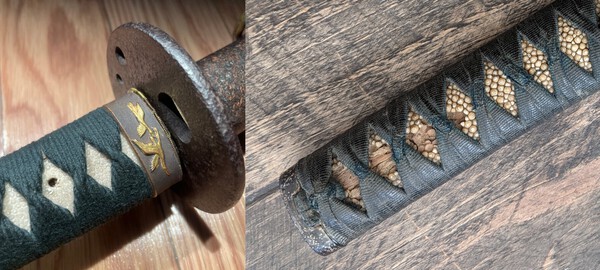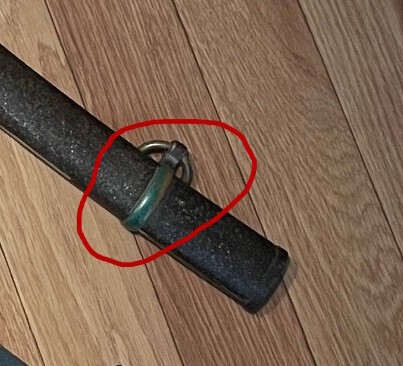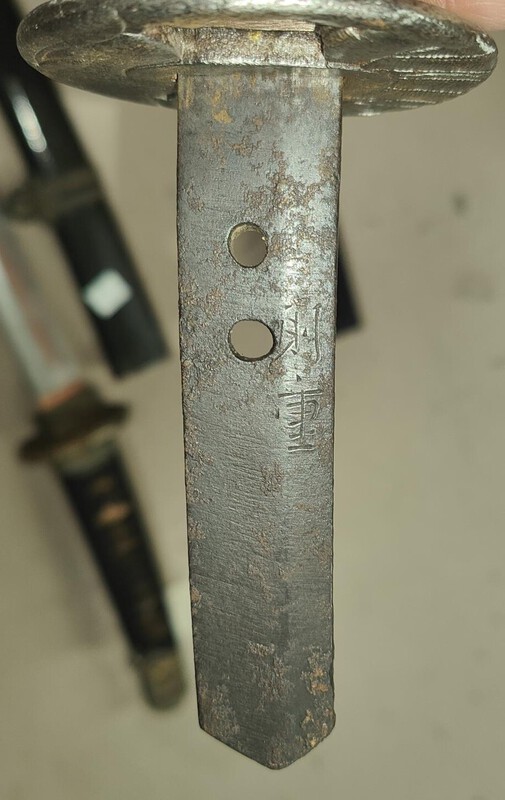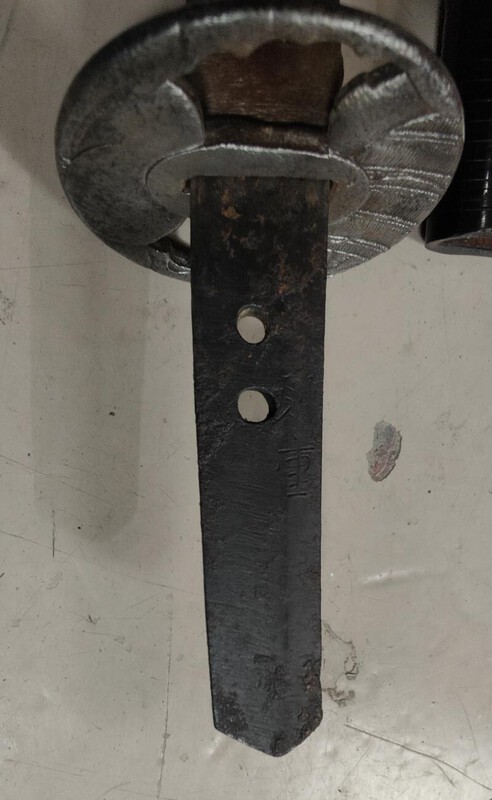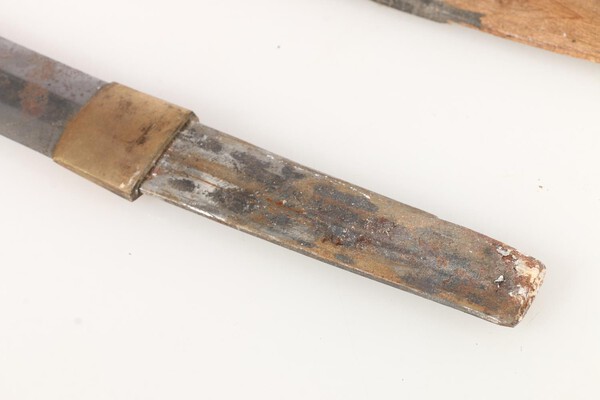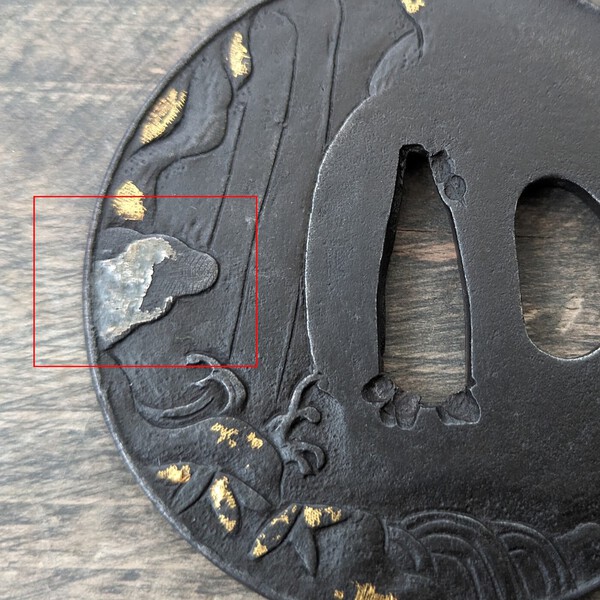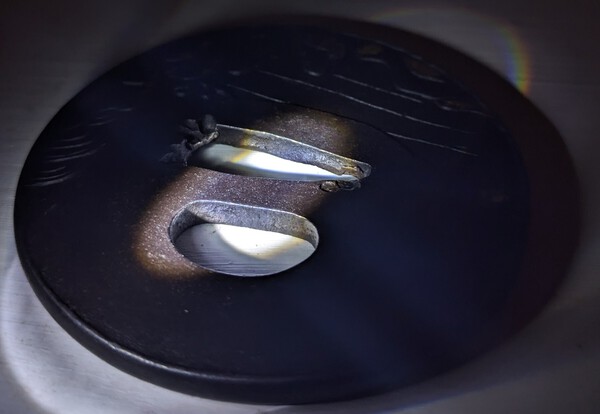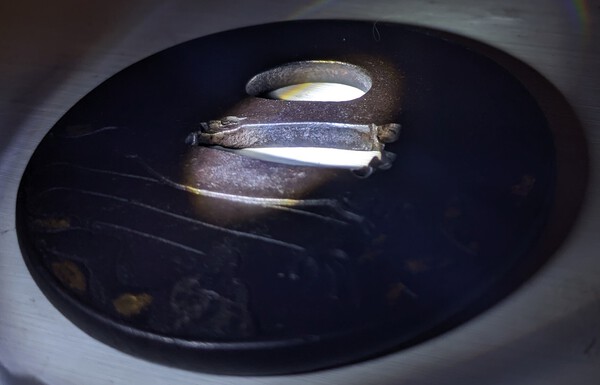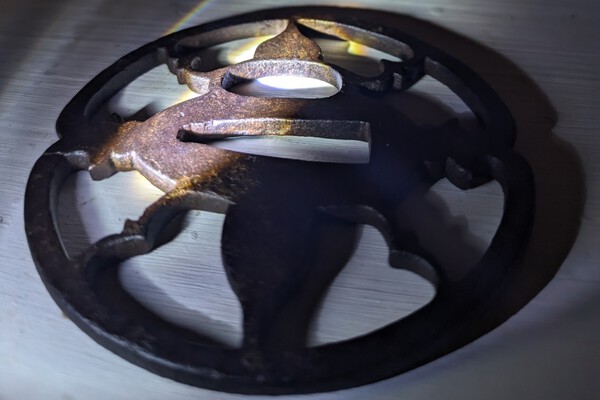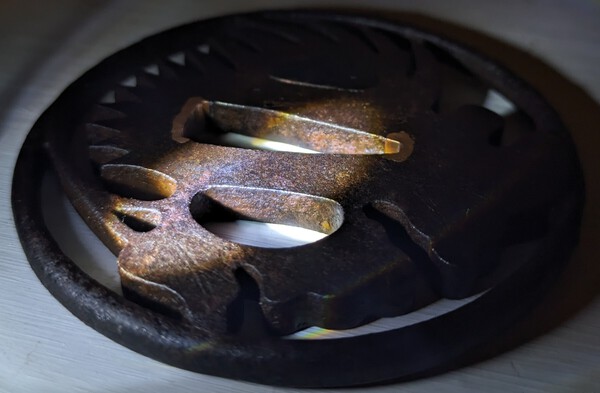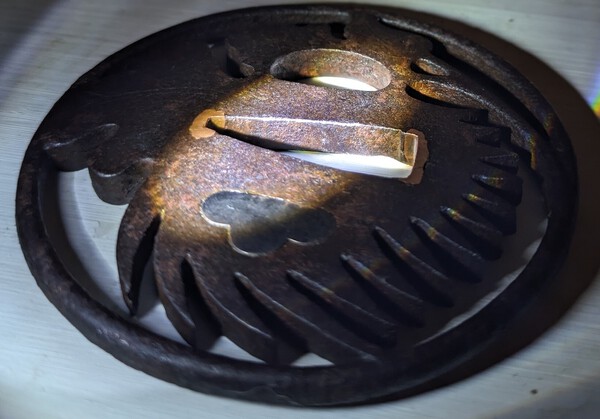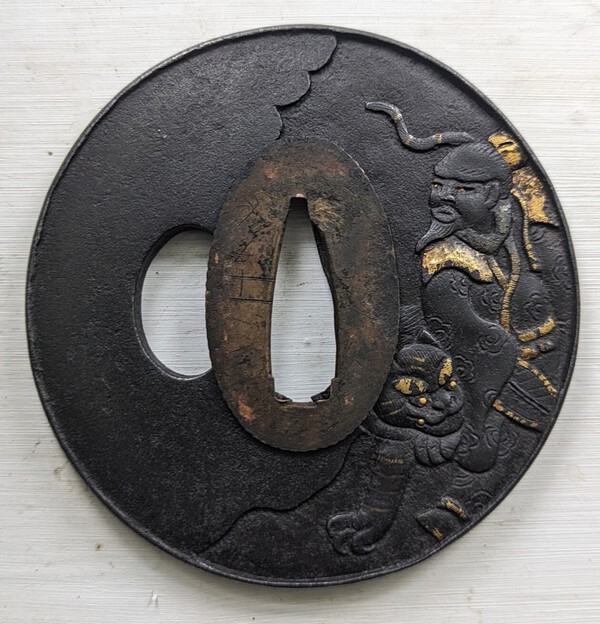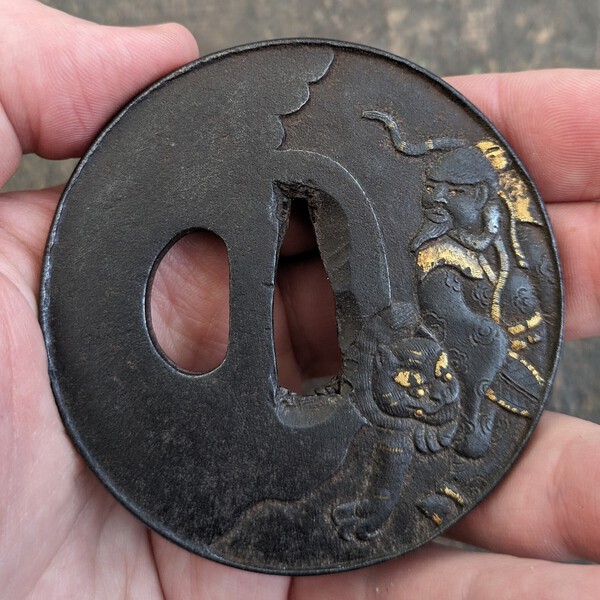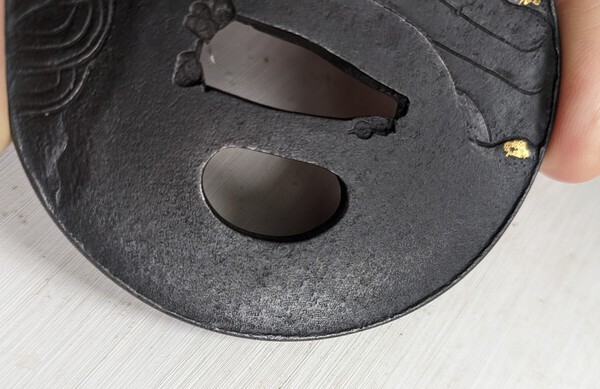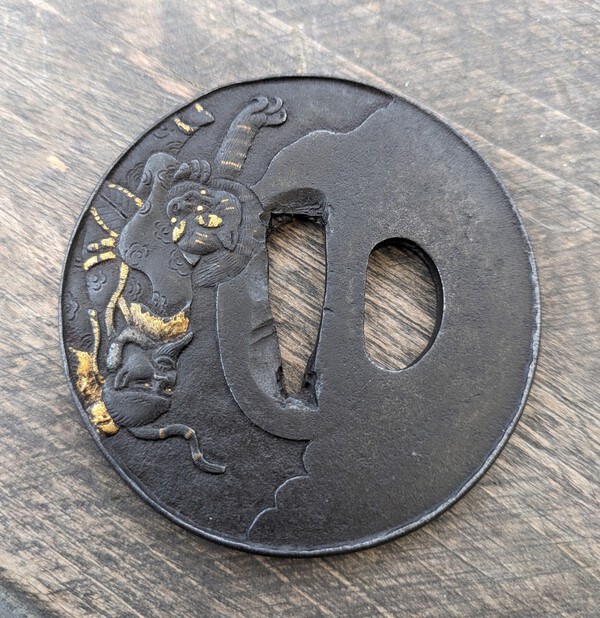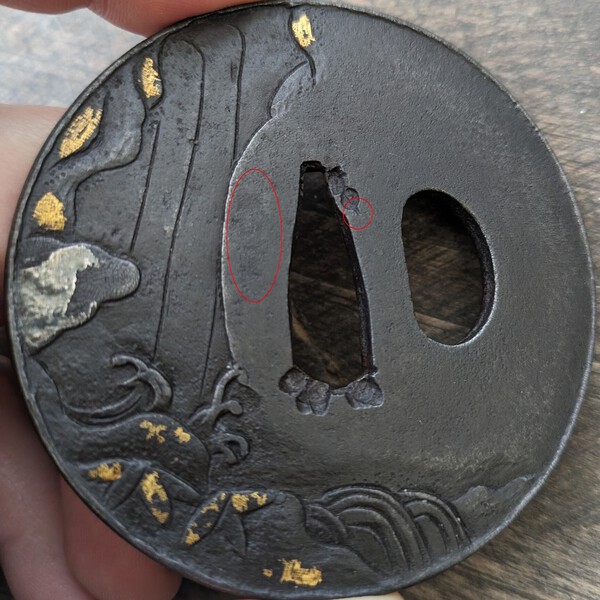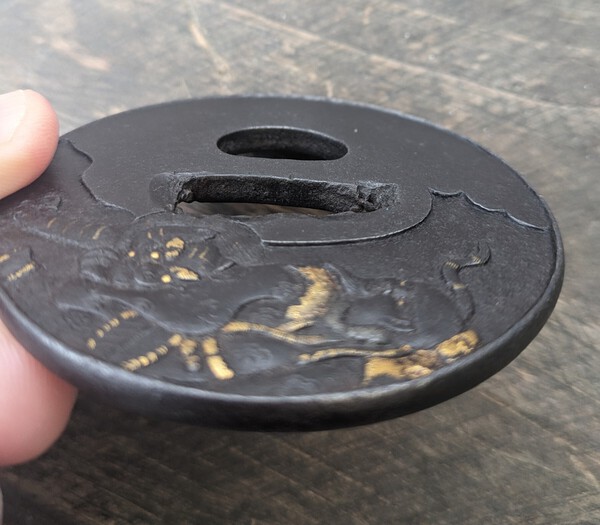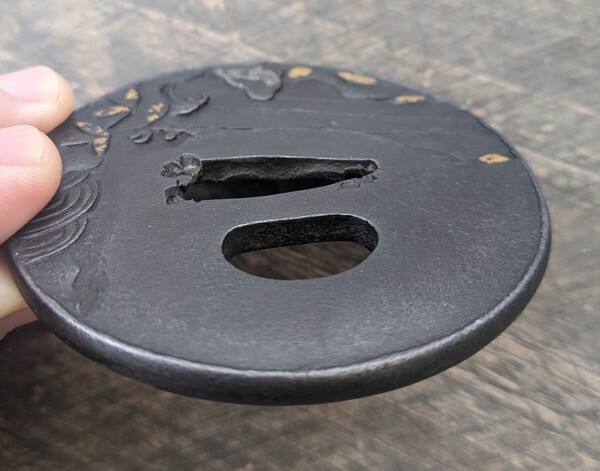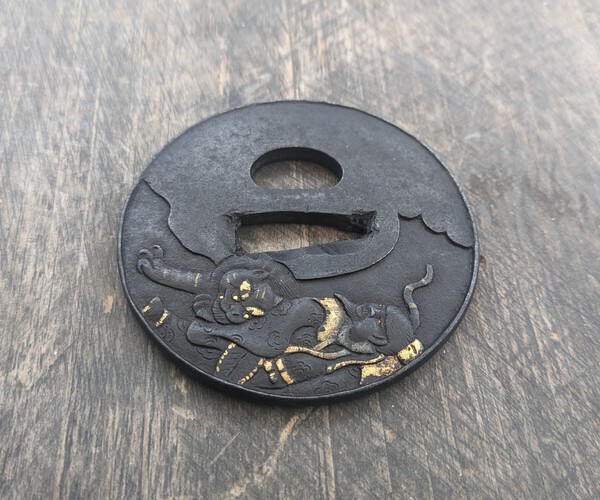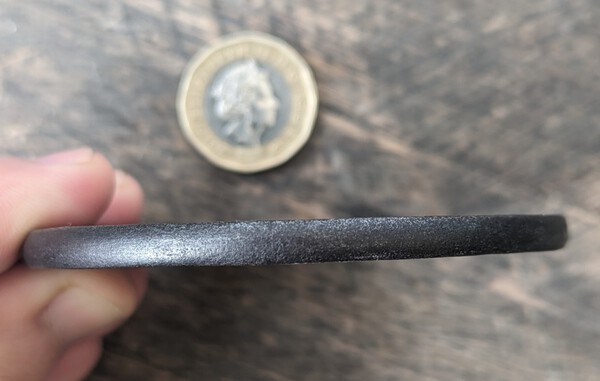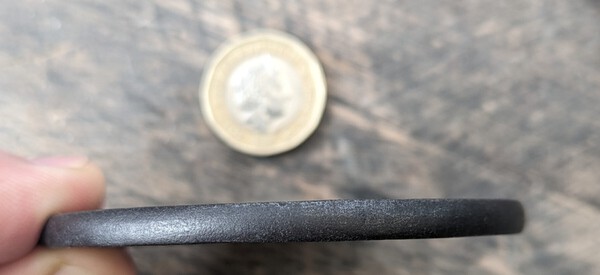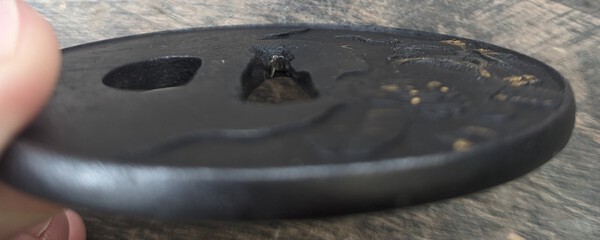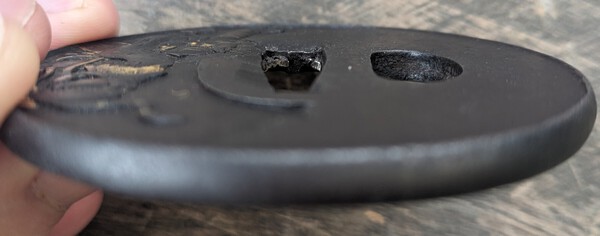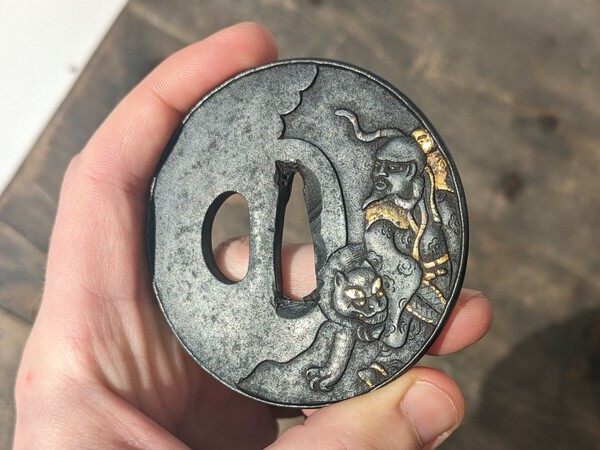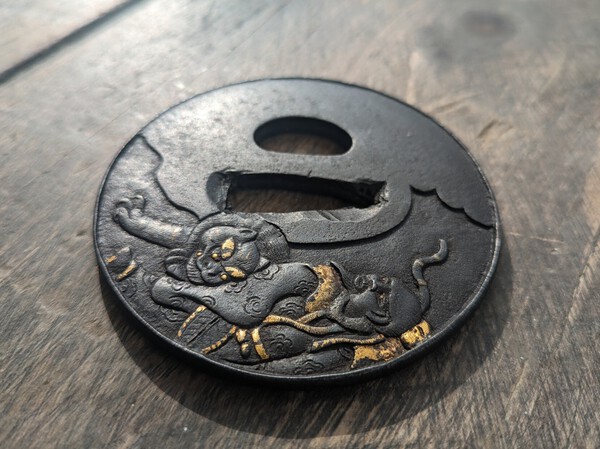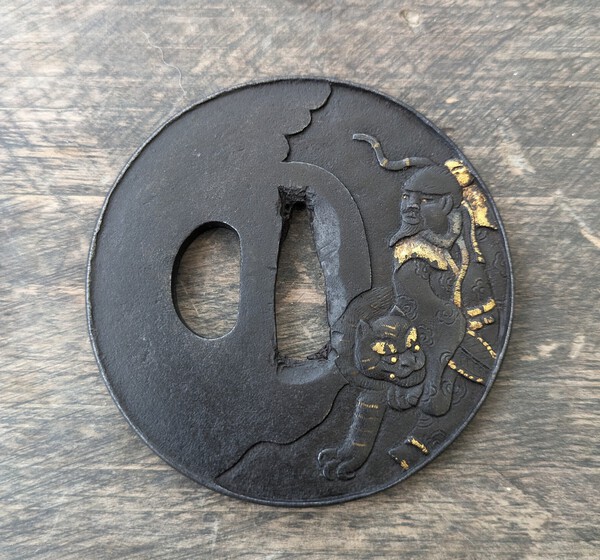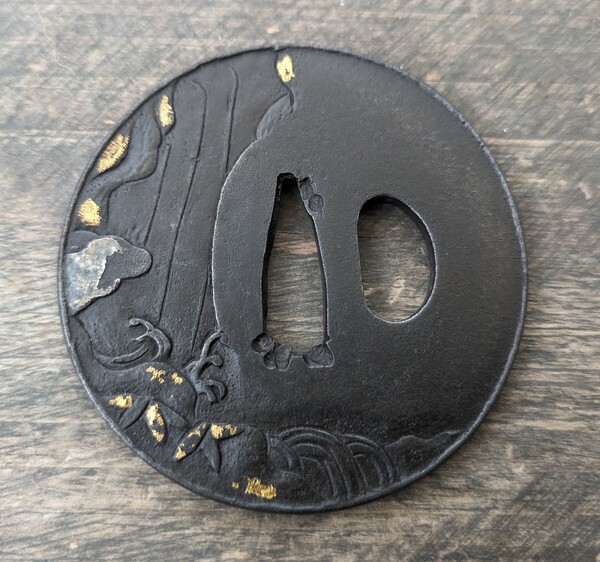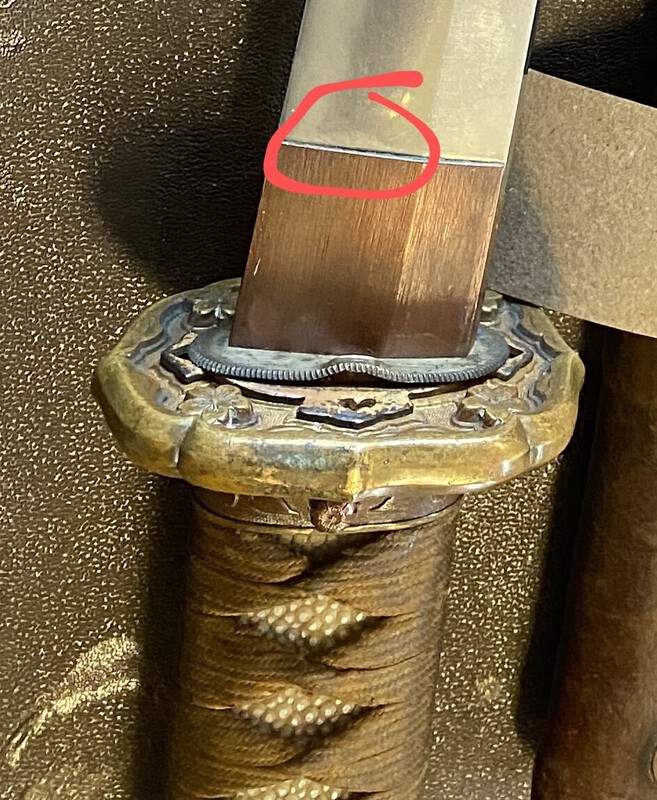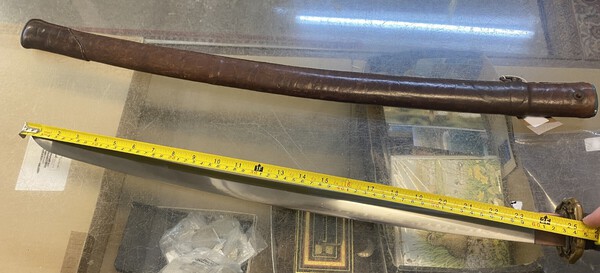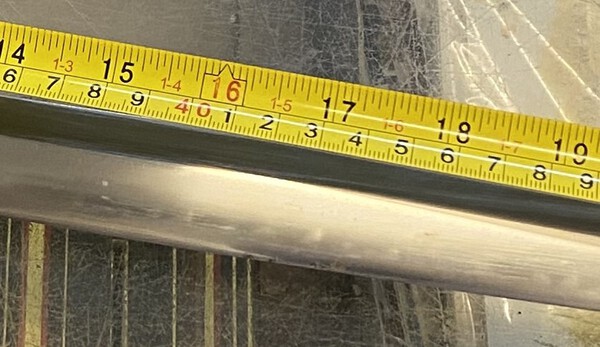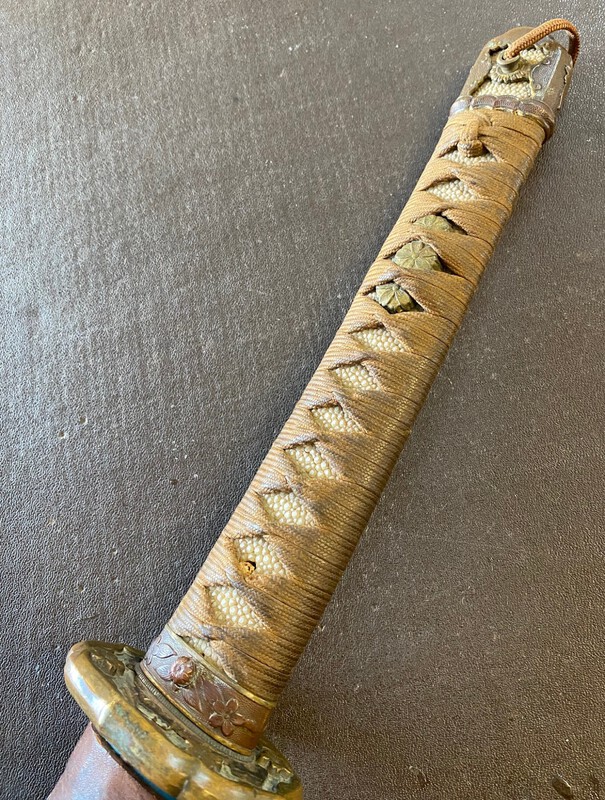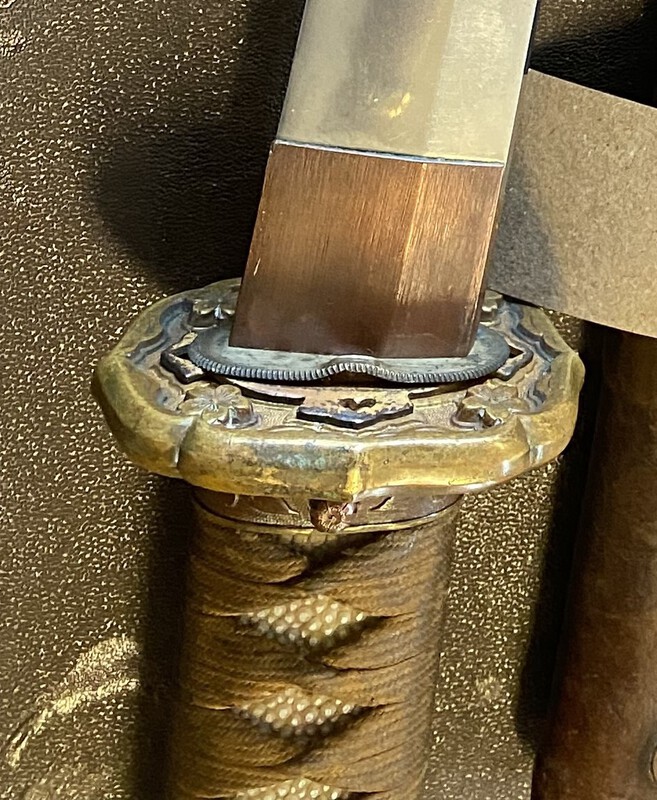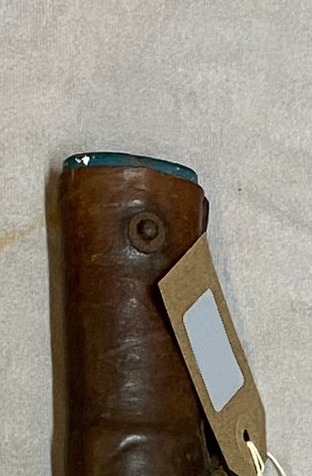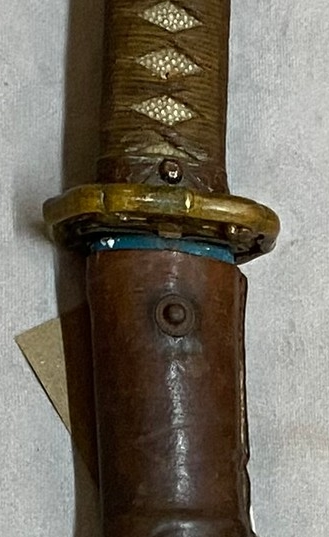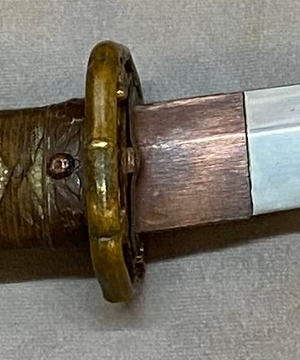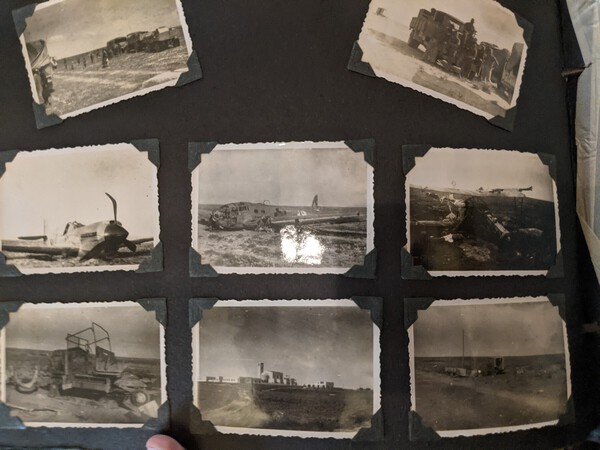-
Posts
228 -
Joined
-
Last visited
Everything posted by George KN
-
Not real is an understatement really! You will never find genuine Nihonto with any big acid-etchings like that. Even the factory-made wartime blades look very different. For example, here's a type 98 gunto (https://en.wikipedia.org/wiki/Guntō), the vast majority of which were made non-traditionally, and look nothing like the sword I bought: And here's a type 95, which is very much factory made, and has a serial number on, but it is stamped in (as in with a hammer), and again looks nothing like mine (be wary of buying these by the way, as there are a lot of fakes floating around): Now there are definitely rougher late-war blades kicking around, some of which were made in China or Manchuria and others made on various islands outside of Japan, which can have wooden handles and are made to a much lower standard, but again the acid-etched stamp really does give it all away. (Useful link here: http://ohmura-study.net/900.html (Why do no Japanese sword sites seem to have working https? )) Its also worth having a read through our own forum section on the wartime blades (if you haven't already!), as I've certainly learnt a lot from it: https://www.militaria.co.za/nmb/forum/45-military-swords-of-Japan/ The real kicker is that you can find the same blade I bought sold in a billion other different places, all sharing the same serial number! We even have an old thread on this forum of them: If only I'd done any sort of reverse Google image search, or tried looking up that serial number before the auction, I'd have even then with my minimal knowledge have realised it was a trap. As a bit of a pallet cleanser though, and also to show the difference in quality - while you won't find acid-etchings on real Nihonto, you definitely can find carvings (horimono), which can be absolutely stunning:
-
@Americankyzen22 - I've just read this entire thread, and as a Nihonto noob myself, there were a lot of terms mentioned whilst discussing this sword that while very useful for research and are very factually correct, aren't always so easy to visualise and understand on first reading. So hopefully nobody minds giving my two pennies worth and some visual examples - but please correct me if I've got the wrong end of the stick, or begin showing too much of my own inexperience Tsuka / Samegawa Firstly, "Badly wrapped tsuka (handle)" and "Fake samegawa" (fake shark/ray skin underneath the material wrap) - here's two of my blades which I think illustrates what people are concerned about, the quality of the material just isn't great, and it isn't showing the amount of wear you would expect. Here's a side-by-side example of a higher-quality tsuka (at least in my opinion) with your tsuka (note how smooth the material is): And here's an example of a genuine, but very worn and cheaper version (I've read that sometimes the larger nodules on the ray skin were glued on in cheaper pieces, and I believe that they have since fallen off in my example): From those two pictures you should be able to see why your own wrap doesn't seem to be made from top notch materials, but also is too clean to likely be an original older wrap. Having a new or newish handle though certainly isn't the end of the world - after all, its a lot safer than having none, and you can always try and buy a better example down the road (although it can be a pain to find one that fits your sword). Hamon / Polish The concerns about the polish, retempering, and hamon are interesting. I am again no expert in this field, but it looks like your blade has two hamon lines: There should only ever be one line here! I simply don't know enough to say much more on this, other than the retempering looks to have been done in a very different way from the original forging (hence the concerns about acid etching and oil tempering, which leave very different hamon lines to water tempering). "...extensive hadaware in the shinogiji..." - this I believe refers to this part of the blade and all the lines up here: Flaws in Japanese swords are known as kizu (https://www.Japanese...rdindex.com/kizu.htm), and this is a form of ware (I think anyway) - they are very common though, but I've not seen such an extensive amount in one place before (I wonder if the retempering has caused these to open or made them worse)? Saya I really don't know much about saya (sheaths), but the main concern seems to be over the loop, which you do see on certain wartime swords and tachi, but not on most katana: It is worth mentioning though that like the tsuka, you can always have a new saya made. Nakago I actually like mumei swords a lot as a new collector - no need to worry about signatures being fake, and although I know little beyond that, I don't see anything that concerns me with yours - it looks genuine, and genuinely old to me. I've added the pictures you sent side by side with my two Nihonto just so you can compare the aging, file marks, ana (hole), and general wear (although obviously the brightness levels in the photos are a little different): Conclusion So what do I think? I think you've actually done better than I did when buying my first Nihonto! Yes, it's retempered and seems to have new fittings, but it at least looks real to me. This was my first sword: It *hurt* when I realised how badly I'd screwed up - and how little research I'd done before bidding on it. But it taught me how little I knew about the subject, and it opened up a whole new world of knowledge which I am still just getting to grips with. Hopefully that's some help? George P.S. I'm sure you already know some of the above terms, but I'm aware it is not just us reading this, and I endeavour to make my posts accessible to future newcomers that also find these threads on Google
-
Thanks for the pdf! The more online resources the better
-
Just for the record @Swords, I do believe genuine Nihonto are almost universally criminally undervalued, especially when compared to other art forms. However, to answer your question: As mentioned in my previous comment, it went to nearly double that value, so ~$600 not $300 I don't have a lot of cash to spare so I have to be very picky with my purchases Risk vs reward generally - $600 spent here (and there is no guarantee the other bidder would have stopped there), means I can't spend it on anything else, so I have to consider what other things may come up in auction later Risk vs reward for this individual sword - there was a fair amount of risk with this particular blade that there was damage to the Boshi. Although I'm not looking for the best blades, I would still like undamaged ones (bit of an ask I know, but that's why I do a lot of leg-work looking) So, yes, if I wanted to guarantee that I find a "good" sword, I would definitely need to spend more money. However, my criteria is likely a bit different from other collectors too - I enjoy the process of testing and increasing my knowledge in the wild by looking at these edge cases, I enjoy a good bargain if possible, but I'm also not too fussed about the current state of polish or a signature, so long as the sword is not irrecoverably damaged and genuine - future richer me can always sort the other issues out. To be honest, I'm still not over the fact I can actually buy 300+ year old noble weapons of justice, death, and status for less than a used car (and sometimes if I'm lucky, less than a new set of tyres). I'd buy every Nihonto on the market if I had the money, since they are just that fascinating and all worthy of preservation, but again, limited funds mean a limited criteria
-
I am once again continuing to trawl auctions and sales looking for cheap Nihonto (not just because budget is limited, but also to help save some unloved history, and I always learn so much, even from failures), and have come across a wakizashi I am personally comfortable buying, but I wanted to sense check a potential purchase first. However, there are several immediate yellow flags: 1. It is being sold with another blade which is clearly a fake acid etched sword 2. The seller describes both as 1900s+ blades with no other details 3. The seller is also selling other modern swords and fittings as part of the same sale 4. I'm 50/50 that the tsuba is completely fake (if its not, what on earth have they done to it?!) 5. The pictures are bad, incomplete, and not all in good focus It is signed, although I have not been given an image of both sides of the nakago. However, I've seen rust faked, and I've seen patina faked, but haven't come across both fake patina and fake rust on the same blade - this one looks right to me. Also, the ana seem to have the expected discolouration on the inside which is nice. The shape is good, the file marks feel right, and the signature doesn't look immediately fake to me (although whether it is gimei I have no idea): The blade itself is very much out of polish, but I can still distinguish a fairly straight hamon - I also haven't seen two bohi like this in a fake blade before. My only concern here is the shape of the kissaki - I can't make out a yokote, and the shape of it makes me think it may have been ground down/polished too much? (Although I am not familiar with all the shapes kissaki were created in). There are what look like ware in several places, again suggesting this is legitimate blade. So what do people think? Am I mad for thinking of buying this, or have I spotted a genuinely missold nihonto? It certainly feels much older than the 1900s to me... Thanks again, George
-
Thank you all for the help on this! I restrained myself from bidding on it today, and it is now someone else's problem... And @2devnul I'm definitely sticking around for the long haul, the forum and community have already saved me from terrible decisions at least half a dozen times over the last year
-
Thank you @Ray Singer! It would seem I am slowly learning something then Is there a proper name for a fragment of a sword like this? I'm somewhat surprised they aren't more common, as I could 100% see people wanting to repurpose a broken blade, especially if it had been in a family for a while. Strange they went to all the effort of cutting it down, but then not actually drilling a hole in it so it could be useable...
-
I am once again considering purchasing something with questionable credentials - but I promise I do try my best to learn from my lessons and generally never ask the same question again! This time is what is being described as a Japanese tanto in rather rough shape. Apart from the light surface rust and deeper rust nearer the edge and tip, I'm fairly confident it is a hand forged blade. However, its a tale of two halves, as below the habaki the nakago is way chunkier than other tanto's I've seen, and there seems to be no hole for tsuka/menuki to use! Now I was previously warned that the last tanto I bought looked like it could potentially be a sword blade that had been cut down: I am still uncertain this is the case with that one (although it has certainly been shortened a bit), but surely this new one below has to be a cut down larger blade if it is missing a hole in the nakago? I can't think of any other reason the blade and nakago are also so thick for its size? It is though a little confusing since the rust seems to indicate it has at least a bit of age too: Any and all thoughts are welcome - just trying to increase my understanding, George
-
Just my two pennies worth as a novice collector - every genuinely made sword is worthy of respect and preservation, and the original sword here being discussed looks in a lot better shape than the majority I've seen in my local auctions! It certainly has both financial, historic, and artistic value even as it is. To me the rust on this blade doesn't actually look deep - I suspect if it is kept in the dry/low humidity conditions and given regular cleaning cycles with a cotton cloth followed by coatings of oil the rust would eventually dry up and begin flaking off - it certainly doesn't look like a lost cause by any stretch of the imagination! What I wouldn't do is touch it with anything abrasive at all, sandpaper included. Obviously opinions of what counts as preservation vary, but I would say just stopping the rust from further damaging the blade is much more important than attempting to make it look shiny again, e.g. the goal is turning the red rust black. Personally I'd be a hundred times happier buying a blade with a bit of extra patina on it than having a bunch of scratches (And this is something I've learnt the hard way myself whilst trying to remove rust from tsuba and scratching them myself - it can be very hard striking the right balance between preservation and restoration)
-
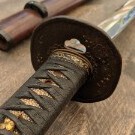
Interesting Pdf Articles And Links
George KN replied to Brian's topic in General Nihonto Related Discussion
I've just stumbled across this amazing thread for the first time, and downloaded a bunch of the pdf's for study later. However, none of these ones seem to work anymore When I use the link provided above (https://www.militaria.co.za/nmb/topic/2062-interesting-book-article-and-pdf-downloads/) I get this: -
Just looked this up too - so to create that effect, the entire flat part of the plate has been repeatedly hammered to create the smooth convex surface? If so, blimey, that must have taken a while! Is this effect ever reproduced in fakes? And similarly, is silver or gold nunome ever used in Chinese reproductions? Lol, a bit too much mystery with this one! I'm now personally feeling a lot more confident in the tsuba being at least handmade and having genuinely been fitted to a sword, even if the styling, patina, and age remain open questions... Also had some further thoughts about the reverse - I think it might actually be a waterfall rather than a bamboo forest, with splashes and foliage at the bottom as the water then makes its way down again.
-
Hi @Matsunoki, thanks for your thoughts too! My mistake, I've edited the post now - I meant silver leaf. I have looked up silver nunome though (another new thing learnt!), and that explains the hashing I've seen on the bamboo forest side to help with adhesion, underneath where the silver has been lost. It also explains why the gold has seemingly worn into a criss-cross pattern too: That's definitely not how normal gold leaf wears, is it? Are nakago ana normally filed? I've compared with some of my other tsuba and they all look similar (apart from the patina, and the fact the others I own have suffered a lot of rust damage): Thanks for the tip on Bonhams though, I will definitely spend some time browsing!
-
Finally, @Spartancrest, I also had the concern about the overlapping seppa when I was originally thinking of buying it in the auction - so I was a little nervous to try this, but I actually think it looks ok, covering only one ear of the tiger: I should also add that regarding the face of the monk (I didn't know about Sennin Bukan Zenshi before, so thanks for that!), his collar has definitely had silver leaf (edit: not gilt) on at some stage, and I also suspect there could have been a touch on his nose too. I am struggling to find similar tsuba with people done in iron like this though - does anyone have further examples? I have found similar depictions of tigers though: Thanks again all for your comments - I'm learning a lot from this
-
I am right now a little lost - I spent most of yesterday running through all the tsuba schools I could find online, and wasn't able to find any combination of fukurin and similar carving style. Does anyone actually have a list of smaller schools, preferably edo and later? Online information seems really sparse for such a broad topic... The crux is, it is completely made of iron - the rim, the plate, and the carvings are all magnetic, and this puts it at odds with the more elaborate later shakudo tsuba it more closely resembles. @FlorianB - I honestly can't rule out it is a fake of some sort, I simply don't know enough to do so yet, but during my searching I also wasn't able to find any similar fakes either! I should add that Stephen's observation on the bulging from the hammer blows is also very evident in person - the metal has bent considerably. I also believe that the "dishing" has happened before the smaller punch notches, as the warping from those overlaps the warping from the dishing. @Steves87 - with regards to the rust and patina, I did clean it on arrival, as there was a light layer of red rust in places, as well as a fair bit of dust. Here's a picture of what it looked like just after I got it from its packaging: It is hard to get it on camera, but the insides of the ana still display some level of rust post cleaning as well. As to the patina, it does seem quite smooth in most pictures, but there is evidence of pitting when you catch the light. It is strange though, almost like it has been struck by many needles: Whilst I was further studying the piece today, I also noticed something completely new - if you turn it upside down and at the right angle, it is possible to see marks from the seppa just above the nakago ana. This was very much a pleasant surprise - and it isn't visible from almost any other angle: Two additional things I've noticed, is that there could be a removed mei on the left of the nakago ana on the bamboo forest(?) side of the tsuba. In addition, there is also what looks like the remains of a chisel mark under the two punches on the top-right side of the nakago ana - I suspect this is contemporary to the dishing, as the dishing all happens on the opposite side, and I suspect something would have been needed on this side to help centre the blade - a chisel mark in this corner therefore makes sense to me, and it has later been punched through:
-
Hi Florian, Thanks for the thoughts - I'm still very much learning, but to me it doesn't look like a cast piece. The insides of the ana both seem consistent with wrought iron, as does the rim, sound, and general feel of it: There's definitely some evidence of wear on the top/bottom of the nagako ana too: But I do agree the styling of the tsuba is different from most - it is nowhere near as flashy as a lot of later pieces, but it also doesn't feel early to me either - was there a revival in older styles at some stage? As to cost, it was just less than £105 (unsure if a lot or a little, I bought it because I liked it). I would be very surprised to find out it wasn't Japanese though 😅
-
I should add the auction description was just: Which was not particularly informative, hence my questions...
-
I bought this tsuba in a UK auction fairly recently because I liked the style and subject matter (who doesn't like a tiger?), but I actually don't know anything about it, and I'm not sure where to begin looking for the school/age/maker/etc. It is a shame its lost a bit of its gold and silver leaf, but I'm a big fan of iron anyhow - and it is actually my first tsuba that I bought that wasn't either attached to a sword or heavily rusted and in need of rescue. By the way, is there a reason the nagako ana has been shaped so much? Does that imply its been fitted to multiple different swords in the past? As always, any thoughts good or bad are welcome, George
-
I didn't realise tanto came in this shape - I always assumed they were shortened from polearms or similar, but yours looks awesome! One question though, doesn't a nagasa of 30cm+ make it too large to be a tanto? For what's it's worth, I also really like the koshirae.
-

Pre-Purchase Questions (Blue saya/leather seppa/hamon)
George KN replied to George KN's topic in Military Swords of Japan
Thanks again @oli & @robinalexander. In the end it sold at auction for £560 + 0.24% auction fees, so ~£700. Although it pained me not to bid higher, I took your advice Rob and walked away - I still want to know what's under that darned handle, but I guess that's someone else's mystery to unravel now On the bright side, I'm still super glad I started this thread, I've learnt so much, so thank you all for the help! The search for a new blade continues... -

Pre-Purchase Questions (Blue saya/leather seppa/hamon)
George KN replied to George KN's topic in Military Swords of Japan
Just relooking over my pictures on my phone, and noticed the hamon returning just before the habaki - that's a bit odd right? -

Pre-Purchase Questions (Blue saya/leather seppa/hamon)
George KN replied to George KN's topic in Military Swords of Japan
Thank you @Ron M, @robinalexander, @Bruce Pennington, and @Tensho for your thoughts, they are very much appreciated! I have had a few more pictures through from the seller now, and it looks like there may be some chips in the blade on the side not previously shown: Do they look like fatal flaws? Also, I've got some extra pictures of the tsuba and seppa. The metal seppa is actually bent! It almost looks intentional... The seller apparently can't remove the tsuka either - he says it is almost stuck on there. I wonder if it has been changed at some point? It would explain the field wrap / chuso mismatch. Finally, does anyone have a running estimate of value when compared to a normal Nihonto? I'm getting much better at valuing traditional swords mentally, but this is my first non traditional blade, and prices seem to range from £500 to £1500 when looking online (I hope to buy it tomorrow). Is that a normal range? And how would you value it without having any idea what's hiding under that tsuka? Thanks again! -
Hi all, I am still learning and non traditional swords are a bit mystery for me, so I'm hoping someone would be kind enough to help verify some things for me before I waste money chasing air. I'm interested in buying this sword, where the buyer has very little information and only two photos so far, but I recognise the military mounts and leather field wrap: There is a small amount of rust on the blade, but I really like the hamon, and I've been after getting a wartime sword ever since I bought my older Nihonto. I have requested further pics (although I'm not sure I'll be able to convince them to remove the tsuka), but for now I have three concerns/queries. 1. Why is the saya blue underneath the leather? Is this traditional/normal? 2. Why is the seppa bending? (Are leather seppa original fittings on such blades?) 3. Does the hamon look oil quenched/machine made? I'm not familiar with the non-traditionally made blades, but if it weren't for the mounts I would have real trouble telling apart this hamon from actual Nihonto. I can't tell if that is my inexperience though... Also, if you see any red flags or issues I haven't noticed, please let me know. I look forward to hearing your thoughts, George
-

Looking for any/all info possible for this sword!
George KN replied to Stockfball11's topic in Nihonto
Just chipping in to say that that looks like a beautiful sword, in good condition, and what an awesome thing for your grandfather to have left for future generations!! I'm also particularly amazed by the holster - funnily enough my own grandad also served in the African and Italian campaigns of WW2, but as part of the British 8th Army - but the only things I have are his medals, a wartime album, and a bucket load of unanswered questions. Any ideas what you plan to do with the sword next? I noticed you had already made a thread about it in 2020:







